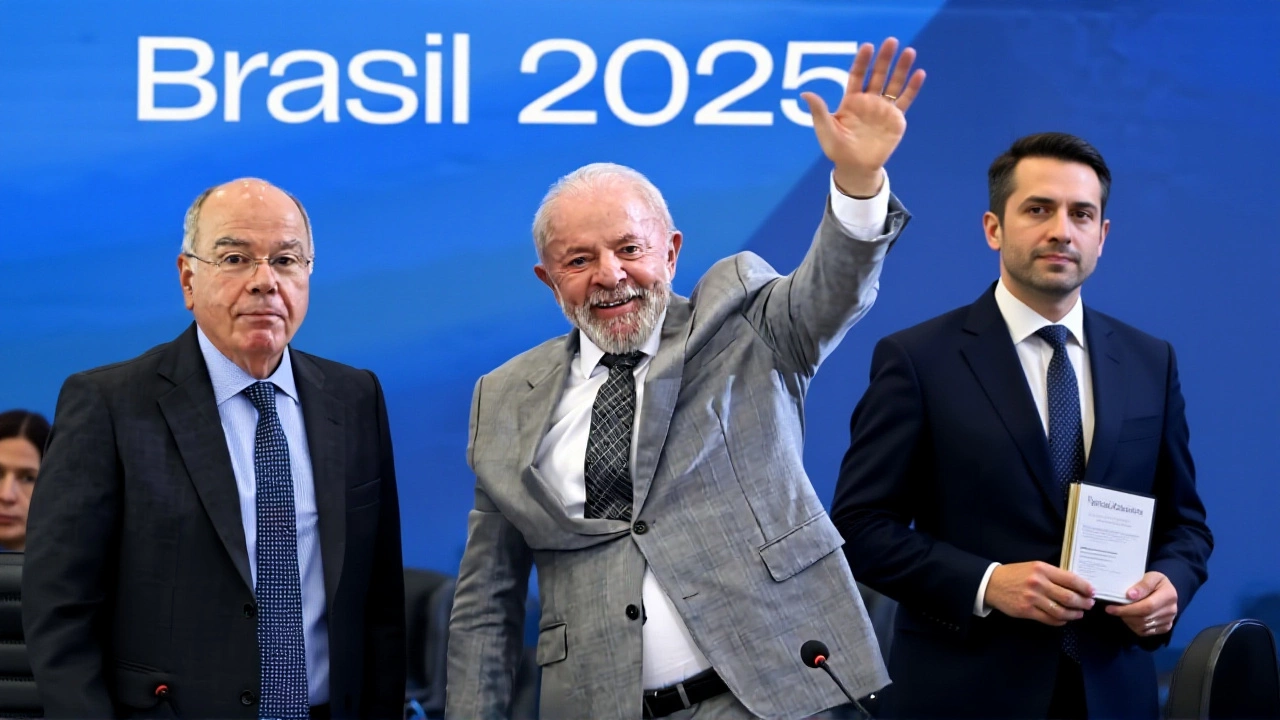Lula Invites Mexico, Colombia, and Uruguay to BRICS Summit in Rio de Janeiro

On March 2, 2025, Luiz Inácio Lula da Silva, the 79-year-old president of the Federative Republic of Brazil, extended a surprise invitation to Mexico, Colombia, and Uruguay to join the 17th BRICS SummitRio de Janeiro — a move that reshaped the geopolitical tone of the upcoming gathering. The invitation came during Lula’s diplomatic trip to Montevideo, where he attended the swearing-in of Yamandú Orsi, Uruguay’s new president. It wasn’t just diplomacy — it was a signal. Lula isn’t just expanding the guest list; he’s redefining BRICS as a platform for the Global South, not just a club of emerging economies.
Why This Summit Is Different
Brazil took over the BRICS rotating presidency on January 1, 2025, after Russia’s tenure ended with the 16th summit in Kazan. But this year’s agenda feels radically different. Where past summits focused on financial coordination and counterbalancing Western institutions, Lula’s Brazil is pushing for something more ambitious: global multilateralism. His mantra — “If there is no free trade, there is no multilateralism, there is no democracy” — wasn’t just rhetoric. It was a direct challenge to the economic isolationism gaining ground in Washington and Brussels.
The summit’s six core pillars — from AI governance to climate cooperation — were carefully chosen to resonate with developing nations. But the real game-changer? The push for local currency settlement. By reducing reliance on the U.S. dollar in intra-BRICS trade, Brazil and its allies are quietly building an alternative financial architecture. And they’re not alone. On July 4, 2025, during the opening of the 10th Annual Meeting of the BRICS New Development Bank in Rio, Lula announced Algeria had joined as a full member — and that Colombia, Uruguay, and Uzbekistan were in advanced talks for membership.
The Latin American Push
The invitation to Mexico, Colombia, and Uruguay wasn’t random. These countries already sit as strategic partners in BRICS. But Lula wanted them in the room — not as observers, but as participants. During the Montevideo event, Yamandú Orsi met privately with Gustavo Francisco Petro Urrego, Colombia’s president, and both discussed deepening technological integration — especially in AI and algorithmic governance. “Sapience on technological development,” Petro called it. It’s an odd phrase, but it captures the mood: this isn’t just about trade deals. It’s about building a shared digital future outside Silicon Valley’s shadow.
Uruguay’s foreign minister, Mario Lubetkin, confirmed the talks were focused on “South American unity.” That’s key. For decades, Latin America has been pulled between U.S. influence and Chinese investment. Now, Lula is offering a third path — one anchored in regional solidarity and BRICS-backed institutions. The message to Washington? You don’t get to dictate who sits at the table anymore.

Who’s In, Who’s Out, and Why It Matters
As of July 2025, BRICS includes eleven full members: Brazil, Russia, India, China, South Africa, Egypt, the UAE, Iran, Ethiopia, and Saudi Arabia — though the latter’s formal entry remains pending. Indonesia’s status is still murky, with conflicting reports. Meanwhile, nine strategic partners — including Bolivia, Chile, Colombia, Mexico, and Uruguay — are being actively courted.
But here’s the twist: the summit didn’t just expand participation. It expanded ambition. The final Leaders’ Declaration, issued on July 7, 2025, explicitly endorsed “increased participation and representation of Latin American and Caribbean countries in global decision-making.” That’s not just symbolic. It’s a direct challenge to the UN Security Council’s outdated structure and the IMF’s voting rules that still give disproportionate power to Western nations.
Lula even floated the idea of BRICS becoming a “non-aligned bloc” — not in the Cold War sense, but as a modern coalition of nations refusing to pick sides between U.S. and Chinese hegemony. It’s bold. And it’s working. At least for now.
The Tensions Beneath the Surface
Not everyone is cheering. Behind closed doors, Chinese officials reportedly expressed frustration over Brazil’s refusal to join the Belt and Road Initiative — a stance Lula has maintained since 2023. Even more awkward? Lula hosted a gala dinner for Droupadi Murmu, India’s president, during the summit. China sees India as a regional rival. Hosting her prominently — and publicly — was seen in Beijing as a deliberate snub.
Still, Lula’s gamble is paying off. The summit drew record attendance from Global South nations. African and Latin American delegations outnumbered those from traditional Western allies. And for the first time, BRICS didn’t just talk about reforming global institutions — it started drafting concrete proposals for them.

What Comes Next
The next move? Formalizing Colombia and Uruguay’s NDB membership by early 2026. Brazil is also pushing for a BRICS development fund focused on renewable energy infrastructure — a direct counter to World Bank lending. And if Mexico joins the NDB next year, the bloc’s economic footprint will stretch from the Arctic to the Amazon.
Lula’s vision isn’t perfect. There are contradictions — Brazil still exports soybeans to China, and its military still buys Russian weapons. But the direction is clear: BRICS is becoming less about economics and more about sovereignty. And for nations tired of being told how to govern, that’s worth showing up for.
Frequently Asked Questions
Why did Lula invite Mexico, Colombia, and Uruguay specifically?
Lula targeted these three because they’re already BRICS strategic partners with strong regional influence and growing economic independence. Mexico is Latin America’s second-largest economy, Colombia leads in AI innovation among Andean nations, and Uruguay is a stable democracy with progressive digital policies. Their inclusion signals BRICS’ shift from economic bloc to political coalition — one that values governance diversity over raw GDP.
How does this affect the U.S. and European influence in global institutions?
The BRICS summit’s push for local currency trade and reform of the UN and IMF weakens Western control over global finance and decision-making. With 45% of global GDP and 40% of the world’s population now aligned under BRICS, institutions like the World Bank and IMF face mounting pressure to share voting power. The U.S. and EU can no longer assume their policies will dominate global agendas.
What’s the significance of the BRICS New Development Bank expanding membership?
The NDB, founded in 2015, now has 11 full members including Algeria and is fast-tracking Colombia, Uruguay, and Uzbekistan. Unlike the IMF, it offers loans without austerity conditions. This gives developing nations real alternatives to Western financial control — and makes the dollar less essential for infrastructure projects. By 2027, NDB lending could surpass $50 billion annually.
Is BRICS becoming a military alliance?
No — and that’s intentional. Lula insists BRICS remains a political and economic bloc focused on multilateralism, not defense pacts. While Russia and China maintain military ties, Brazil and India have consistently rejected any security cooperation framework. The summit’s emphasis on AI governance and climate action, not arms deals, shows its priority is sovereignty through economic and institutional reform, not confrontation.
What’s the likelihood of Mexico joining BRICS as a full member?
Mexico’s path to full membership is likely by 2027. Its economy is the 15th largest globally, and it’s already deeply integrated into BRICS supply chains — especially in auto parts and electronics. But Mexico’s close ties to the U.S. make formal entry politically sensitive. Lula’s invitation is a test: if Mexico participates actively in Rio and joins the NDB, full membership will follow.
How does this summit compare to past BRICS gatherings?
Previous summits focused on financial coordination and anti-Western rhetoric. This one shifted to governance reform, AI ethics, and climate resilience — themes that resonate beyond BRICS members. For the first time, non-member Latin American nations were invited to co-draft agenda items. The tone was collaborative, not confrontational. It wasn’t just a meeting — it was a movement.

Kirim Komentar